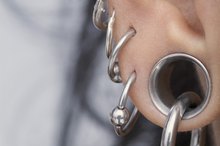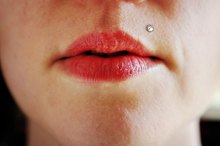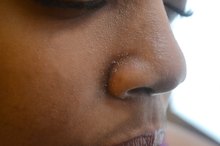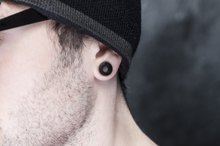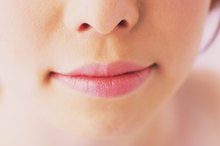Dry Skin Around a Nose Piercing
Nose piercings are a popular form of body piercing in the United States and around the world. These piercings are placed through the fleshy, noncartilage lobe of one of the nostrils, typically being adorned with a stud or small loop ring. Because of the location, though, nose piercings can be somewhat difficult to take care of, and irritation to the piercing is possible 1.
Dry Skin Cause
The skin around a nose piercing is often sensitive during the first several weeks after the piercing is done. If the skin is exposed to harsh winds and/or cold, it can be one of the first parts of your body to develop dry, cracking skin. But if you wash the piercing too frequently and/or use harsh soap chemicals to do so, these can irritate and dry out the skin as well.
Significance
The Healing Process of a Nose Ring
Learn More
Dry skin can be uncomfortable and cause redness at the location, making your piercing look bad. If the dryness leads to cracking, it can break open the skin and increase the risk of an infection in the piercing. This may require you to abandon the piercing and seek professional treatment to heal the infection and the open wound.
- Dry skin can be uncomfortable and cause redness at the location, making your piercing look bad.
- If the dryness leads to cracking, it can break open the skin and increase the risk of an infection in the piercing.
Treatment
Dry skin is best treated by applying a moisturizing cream at least twice each day. You should also avoid harsh weather that might exacerbate the piercing. If soaps and chemicals are causing the dryness, consider using different soaps featuring milder chemical agents and/or natural cleansers to reduce the agitation to your skin.
Prevention/Solution
What Are the Dangers of Pierced Ears?
Learn More
Using gentler soaps and moisturizing before dryness develops can prevent the condition from developing in the first place. Be careful when handling your piercing, and wash your hands prior to touching it. Minimize the amount of time you spend touching the piercing and messing with the stud, and avoid washing the skin excessively -- more than two times a day can strip away your skin's natural oils and increase the risk of dryness.
Warnings
If the skin starts to crack, you should visit a doctor to have the piercing inspected. Open wounds can create other potential problems when piercings are involved. Additionally, if you experience any other symptoms beyond the dry skin, visit a doctor to determine whether the dry skin is related to the other symptoms. This may be a warning sign of other problems related to your piercing that need medical attention.
- If the skin starts to crack, you should visit a doctor to have the piercing inspected.
Related Articles
References
- Harvard University: Proper Nose Piercing Care
- National Conference of State Legislatures. Tattooing and body piercing | state laws, statutes and regulations. March 13, 2019.
- Koenig, L. M., & Carnes, M. (1999). Body Piercing: Medical Concerns with Cutting-Edge Fashion. Journal of General Internal Medicine, 14(6), 379–385.
- Palo Alto Medical Foundation, Body Piercing
- National Conference of State Legislatures. Tattooing and body piercing | state laws, statutes and regulations. March 13, 2019.
- American Academy of Pediatrics. HealthyChildren.org. Body piercings, teens & potential health risks: AAP report explained. Updated September 18, 2017.
- Johns Hopkins All Children’s Hospital. Adolescent tattoos, body piercings and body modifications. November 21, 2017.
- Koenig, L. M., & Carnes, M. (1999). Body Piercing: Medical Concerns with Cutting-Edge Fashion. Journal of General Internal Medicine, 14(6), 379–385.
- Palo Alto Medical Foundation, Body Piercing
Writer Bio
Jonathan Croswell has spent more than five years writing and editing for a number of newspapers and online publications, including the "Omaha World-Herald" and "New York Newsday." Croswell received a Bachelor of Arts degree in English from the University of Nebraska and is currently pursuing a Master's of Health and Exercise Science at Portland State University.

